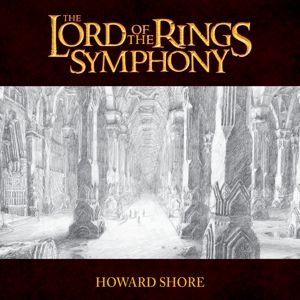
The Lord of the Rings Symphony
Music composed by Howard Shore
Conducted by: Ludwig Wicki
Performed by: The 21st Century Symphony Orchestra and Chorus
Album time: 115 minutes (2 discs)
Available on Howe Records
Taken from all three Lord of the Rings films and more than twelve hours of music, the Lord of the Rings Symphony encompasses the journey of the characters in the film as well as the thematic material from the scores. If you know the films well, the music follows them nicely. This newly conceived symphony has been touring the world to popular acclaim.
I’m by no means an expert on every motif and theme, but I’ll put a few notable ones as they appear. I wanted to showcase the music in the Symphony and see how the Symphony itself is constructed. The album follows this plan:
Movement 1-2: Fellowship of the Ring
Movement 3-4: The Two Towers
Movement 5-6: Return of the King
Movement 1 opens with the Prologue, which takes about half of this movement. We then enter the Shire and hear the Hobbit theme. The orchestration seems richer in certain sections, with different instrument additions. The choir is heard heavily in the next section, featuring the music as the Hobbits escape the Nazgul.
Movement 2 begins with the beautiful Rivendell theme. The female section of the choir sounds beautiful with the cello soloist. The Hobbit theme appears in its many iterations in the movement as well as the first stirring rendition of the Fellowship theme. The low men’s choir signifies the depths of Moria and we hear the first version of Gollum’s theme. This rendition of the Dwarrowdelf theme is spectacular. The female choir and soloist take over for much of this 34 minute movement. The momentum really builds up in the following section, featuring the Isengard theme. At the end of the movement, we hear the music for the end of movie, and my personal favorite of the trilogy. This is the The Breaking of the Fellowship which features the excellent boy soloist in the song In Dreams.
The Fellowship movements are the most cohesive parts of the symphony, with the sections of the score blending seamlessly.
Movement 3 is The Two Towers, starting with the Ring theme. The creepy Gollum theme appears, played on one of the more exotic instrument of the orchestra – the cimbalom. We hear Eowyn’s theme and the stirring Rohan theme, and eventually played as the violin solo. This movement contains more slow and quiet moments, like Evenstar. This movement has unique instrumentation and contains a bunch of quiet choir moments.
Movement 4 begins with a big introduction of the Rohan theme on horn. We get some of the best score moments of the film in this movement, notably Gandalf returning, Theoden riding out, and the beautiful nature theme. The movement ends with Gollum’s Song.
Movement 5 begins with a few quotes of the Fellowship theme, and eventually the Gondor theme in the spectacular Lighting of the Beacons (certainly the highlight of this movement). Many other past themes come back briefly and each of course has varied since the beginning. The movement segues into the next movement.
Movement 6 starts with a military nature, due to the parts of the film it represents. It features the choir prominently and female soloist. A bass soloist sings Aragorn’s coronation song, which sounds completely different than the actor’s version. One of the best moments in the movement is the reprise of the Shire theme. From then on, we hear a majority of the music from the ending of the film. The song Into the West is introduced by the orchestra, before the singer takes over.
Overall, this re-recording is not a huge step down from the original recordings. The soloists, choir and orchestra are all really excellent. Unlike other re-recordings, this maintains the original tempos. The arrangements and orchestrations have changed, so it is not identical to the original soundtracks. The choir is certainly louder in this recording than the original in several spots. It is great as a condensed version of the great moments of the scores, especially if the Complete Recordings are too much of a good thing. It works both as a great introduction to the film scores or great streamlined highlights for those already familiar with the scores.
I hope the symphony continues touring, and this album is a great representation of scores. From the films to the symphony, it really is there and back again.




0 Comments